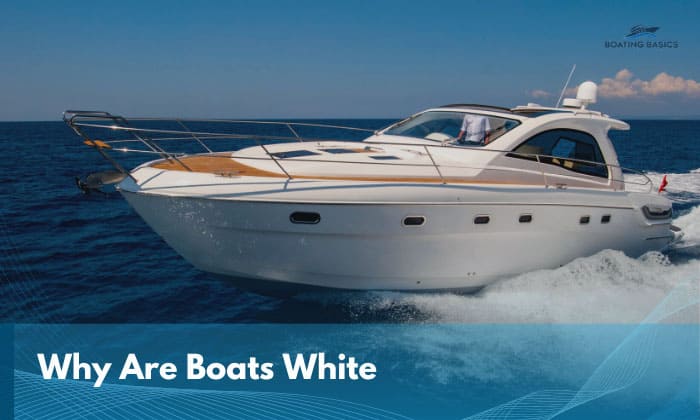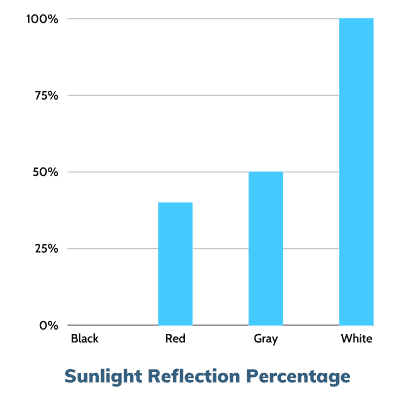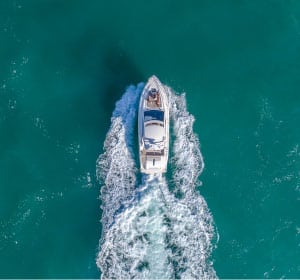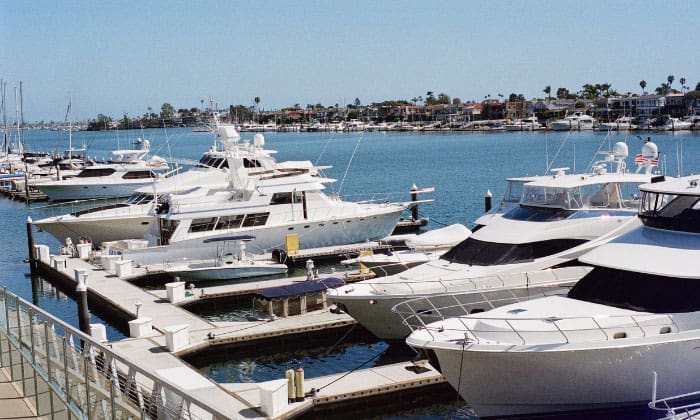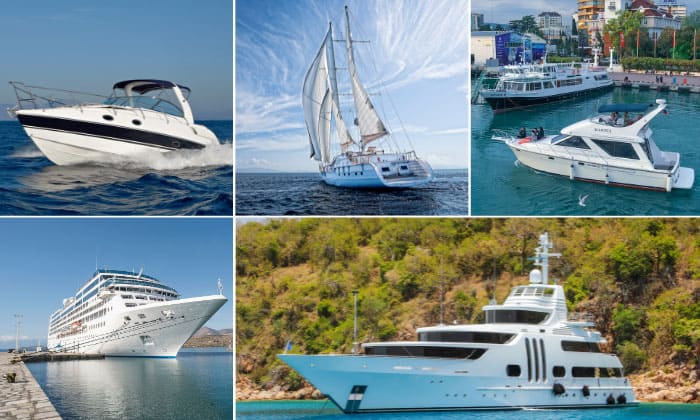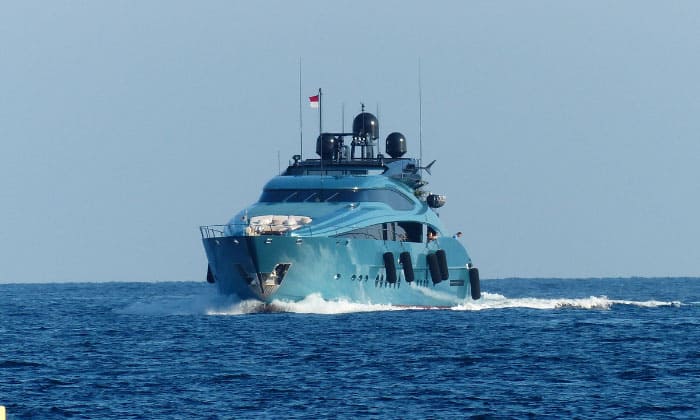I imagine most people who gaze at the wondrous, chalky form of cruise ships and sailboats traversing open waters will, one way or another, ask, “Why are boats white?”
Well, being able to immediately notice that most cruise ships are white already tells you one of the reasons why. The color makes them more visible, especially in their typical water and sky background.
Other practical purposes of painting boats white are heat and UV reflection, cost reduction, and easier detection of superficial damage. Besides that, white can be stylish, too.
Table of Contents
Why Boats Are Painted White
Based on the answers above, builders evidently paint most boats white more out of practicality than aesthetics. Make no mistake, white is the top choice among cruise ship colors because it adds to their pristine majesty.
However, builders will be quicker to point out the following reasons when explaining their decision to paint the hulls of their creations mainly with this color.
1. It keeps the boat’s interior cool
Just by observing how the sun beats down on boats, especially on a clear day, you’ll probably take every opportunity to keep your vessel cool.
We have mainly the color white’s ability to reflect an almost full beam of sunlight to thank for keeping their interiors cool.
By reflecting 100% of the sunlight, having the hull painted white takes care of the possible extra heat absorption that might happen, which only means bad news for everyone on board.
Refer to this table for how various sailboat hull colors reflect sunlight:
| Color | Sunlight Reflection Percentage |
| Black | 0% |
| Red | 40% |
| Gray | 50% |
| White | 90% to 100% |
As you can see, by painting your hull black, you essentially create a sauna-like environment in your boat, requiring you to install more powerful air conditioning systems to beat the heat.
Lighter colors, especially the lightest one as in the case of our main topic, create an opposite environment – one that’s characterized by comfort and more energy-saving.
2. Reduces boat manufacturing costs
Boat manufacturers paint most yachts white because they cost just as expensive to make, and they want not to have to shell out too much money to get their creations in the market. It’s not like choosing white paint has any major downside, too.
White paint is readily available, making them more cost-effective, especially if we compare it to more customized choices. You often have to pay extra just to get the personalized color you want because they require more resources.
3. Boosts visibility
Who says red and green are the sole attention-grabbing colors to the human eye? If we put white among the usual cerulean hues of the sea and sky, it proves to be equally arresting – to the point of being blatant eye magnets among more opulent vessels out there.
Contrast figures a lot in the mix of white and blue colors, allowing the former to stand out, and yes, that still rings true if you gaze at many a waxen vessel from a distance.
4. Easier to spot damage and imperfections
Rust with its dark brown or orange hue can quickly be spotted once it rears its ugly head on white hulls. The same goes for when algae and barnacles start growing on them.
Darker-colored vessels end up masking these issues, so boat owners only end up taking remedial action once the infestation has progressed substantially.
We can manage to stay a step ahead of these issues and perform the necessary maintenance and repair, thanks to the hull color of the vessels.
It’s also easier to inspect the surface for even the smallest signs of scratching, fading, and oxidation. The result is a vessel that still looks none the worse for wear after a decade – I’ll definitely take that any day over painting it with my favorite colors as a thrifty boat owner.
5. Hides irregularities in the hull
Boat builders almost immediately paint their vessels with a white gel coat to hide imperfections in the hull. If darker hues like red, blue, and black, they readily become more apparent.
Also, not all boatbuilders have molds suitable for producing hulls painted with those colors. White proves to be an exemption.
Moreover, white may conceal filler and putty, giving the hull a smoother and flawless-looking surface – regardless of how much the two were used to get the desired finish.
Does the Color White Impart Any Special Meaning in the Context of Boats?
Most folks associate it with luxury and purity. If there are qualities that more refined and sophisticated vessels like cruise ships and yachts can’t have enough of, these two definitely make the cut.
We can’t deny that white is a very clean-looking color, and you can’t get a more “antiseptic” color than it. Let’s just say that that’s what its color code mainly stands for, aesthetically speaking.
Benefits of a White Boat
- The increased visibility ensures it will be easily spotted, even in low-light conditions, which, in turn, guarantees its and the passengers’ safety.
- The way it reduces heat absorption guarantees everyone on board will be kept cool even during the hottest months or in tropical countries, which cruise ships frequent.
- It makes the boat easier to maintain. If you address problems once you spot them, you can keep a white boat in good, working condition for years.
- White is a neutral color that you can conveniently customize and stylize.
- These vessels essentially stick to tradition and sport a classic, timeless look that never runs out of its universal appeal.
How It Became the Most Popular Boat Color
Vessels are painted mostly white precisely because of the reasons mentioned above. Arguably, no other colors can deliver the same combination and number of advantages.
- The symbols associated with it, particularly elegance, have made it the preferred color of sailboats, yachts, and cruise ships.
It can be argued that certain shipbuilders simply don’t want to let go of that maritime heritage and tradition – and why would they see no other color that imparts similar benefits to their beloved vessels?
- You keep everyone on board safe, and comfortable, and all the while, the boat is given a luxurious touch and made more durable and long-lasting.
A win-win situation, in short, that’s hard to let go.
Types of Boats With a White Color
We generally refer to boats when talking about the white color they sport. This is why it’s safe to say that almost any kind of boat can be painted white and enjoy the benefits mentioned here.
See for yourself by heading to your local marina or dock to check out the following:
- Motorboats
- Sailboats
- Yachts
- Center consoles
- Cruise ships
Chances are, you’ll see rows of white vessels with touches of various colors here and there.
Other Colors That Can Be Used on Boats and Why
Just because white provides overwhelmingly superb advantages doesn’t mean that boats should limit themselves to that. For instance, do you know what color represents fishing ships?
The answer is that it depends. Fishing boat operators exercise all the freedom and creativity in the world when choosing the hues of the camouflage they want to go for, for example.
And, this is even though the color of your boat doesn’t affect your chance of catching fish that much. In short, most boat operators can opt to customize their boat’s colors.
They just have to be prepared to pay a more premium fee than the default white their vessel comes in. Once you decide to go this route, though, don’t be surprised if your chosen color will suddenly highlight the irregularities that the original white color was masking.
Conclusion
All in all, the answers to the query, “Why are boats white?” are based on the color’s undeniable advantages in ensuring safety, comfort, boat longevity, and money-saving, and that the boat will have a charm that’s based on the purity and luxury that we associate with the color.
In an industry that values practicality, it’s not at all surprising that it has become the norm. After all, we boaters almost always want to be able to focus on the job or endeavor at hand, whether it’s cruising, fishing, or simply relaxing.

“My intention from the first day establishing Boating Basics Online is to provide as much help as possible for boaters who want to experience a first safe and convenient trip. So feel free to join us and share your beautiful journeys to the sea!”

